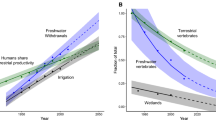Abstract
Approximately 70% less water flows through the Everglades ecosystem today compared with the historic Everglades, and the quality of the remaining water is often degraded. The regionally managed hydropattern does not follow the pre-drainage distribution, timing, and duration of the natural Everglades, nor can water move freely though the remaining Everglades. As a result, there have been significant reductions in wildlife and fish populations, their habitat, and the environmental services wetlands provide society. Both the problems of declining ecosystem health and the solutions to Everglades restoration center on restoring the quantity, quality, timing, and distribution of water. The Comprehensive Everglades Restoration Plan consists of over 60 civil works projects that will be designed and implemented over a 30 year period. At an estimated cost of $7.8 billion, it seeks to correct an earlier attempt at water management in South Florida and improve water availability during the dry season and reduce flooding of urban and agricultural areas during the wet season. The plan calls for storage and controlled release from more than 217,000 acres of new reservoirs and wetland-based treatment areas and from over 300 underground aquifer storage and recovery wells. The plans assumes that during retention in stormwater treatment areas, the excess phosphorus, nitrogen, agrichemicals such as atrazine, diazinon, endosulfan, and other contaminants will be reduced before release into the natural areas. It also assumes that little or no change in water quality will occur during underground storage. To improve the hydraulic connectivity of natural areas, some of the extensive system of levees and canals within the Everglades will be removed in an effort to improve overland water flow. Most of the current planning has focused on water storage and restoring basic hydrology in the remnant natural areas and on phosphorus removal as a benchmark of water quality. The restoration plan, as approved by Congress, is conceptual and most of the details, including potential impacts of the plan on the natural system and the role of contaminants remain to be evaluated.
Similar content being viewed by others
References
Colborn, T., vom Saal, F.S. and Soto, A.M. (1993). Developmental effects of endocrine-disrupting chemicals in wildlife and humans. Environ.Health Perspect. 101, 378–84.
FDEP (1996). In J. Hand, J. Col and L. Lord (eds). Water-Quality Assessment for the State of Florida; Technical Appendix South and Southeast Florida.1996 305(b) Report. Florida: Department of Environmental Protection.
Frederick, P.C. and Spalding, M.G. (1994). Factors affecting reproductive success of wading birds (Ciconiiformes) in the Everglades Ecosystem. In S.M. Davis and J.C. Ogden (eds). Everglades: The Ecosystem and Its Restoration. pp. 659–92. St. Lucie Press.
Lange, T.R., Royals, H.E. and Connor, L.L. (1993). Influence of water chemistry on mercury concentration in Largemouth Bass from Florida lakes. Trans.Amer.Fish.Soc. 122, 74–84.
National Research Council (2002). Regional Issues on Aquifer Storage and Recovery for Everglades Restoration. Washington, DC: National Academies Press.
Roelke, M.E., Schultz, D.P., Facemire, C.F., Sundlof, S.F. and Royals, H.E. (1991). Mercury Contamination in Florida Panthers. Prepared by the Technical Subcommittee of the Florida Panther Interagency Committee.
US Army Corps of Engineers (1996). Florida's Everglades Program. Everglades Construction Project. Final Programmatic Environmental Impact Statement. Jacksonville District Corps of Engineers, Jacksonville, FL.
US Army Corps of Engineers and South Florida Water Management District (1999). Central and Southern Florida Project Comprehensive Review Study, Final Integrated Feasibility Report and Programmatic Environmental Impact Statement. United States Army Corps of Engineers, Jacksonville District, Jacksonville, FL, and South Florida Water Management District, West Palm Beach, FL.
Ware, F.J., Royals, H. and Lange, F. (1990). Mercury Contamination in Florida Largemouth Bass. Ann Conf. Southeast Assoc. Fish & Wildl. Agencies.
Author information
Authors and Affiliations
Rights and permissions
About this article
Cite this article
Perry, W. Elements of South Florida's Comprehensive Everglades Restoration Plan. Ecotoxicology 13, 185–193 (2004). https://doi.org/10.1023/B:ECTX.0000023564.10311.4a
Issue Date:
DOI: https://doi.org/10.1023/B:ECTX.0000023564.10311.4a




